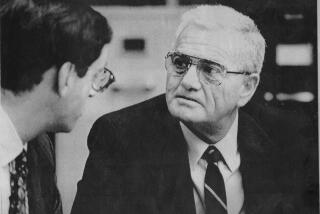THE O.J. SIMPSON MURDER TRIAL : Collecting Evidence
- Share via
How significant were some of the “errors” in evidence collection admitted by criminalist Dennis Fung?
Sealed wet blood samples in plastic bags, allowing degradation of DNA by bacteria.
A degraded DNA sample gives no result, not a false result. A degraded DNA sample thus cannot produce a false identification--the DNA fingerprint of another person. If a sample produces a positive result, then it was not significantly degraded. If it is
degraded, it benefits the defendant.
Didn’t use fresh gloves and tweezers to collect each blood specimen on the scene.
Fung used a moist tissue to wipe off any blood so there were no visible traces of blood on either, a practice followed in most laboratories. For the conventional DNA fingerprinting technique, called RFLP, this would be adequate to prevent contamination because RFLP needs a dime-sized sample of blood. For the more sensitive, but less reliable, technique called PCR analysis, it could have introduced some contamination. A sample about one-twentieth the size of the head of a pin will produce a positive test.
Didn’t count number of cotton swatches used on each blood sample.
Failure to count swatches could make it impossible to document the chain of custody for the blood samples. It is impossible to know if one or more swatches disappeared. A good investigator should document everything.
Didn’t pick up piece of paper on lawn at murder site.
All evidence should be collected.
Sources: Mark Stolorow, Cellmark Diagnostics; Ed Blake, Forensic Science Associates; Anthony Longhetti, Cal State Los Angeles.
More to Read
Sign up for Essential California
The most important California stories and recommendations in your inbox every morning.
You may occasionally receive promotional content from the Los Angeles Times.










